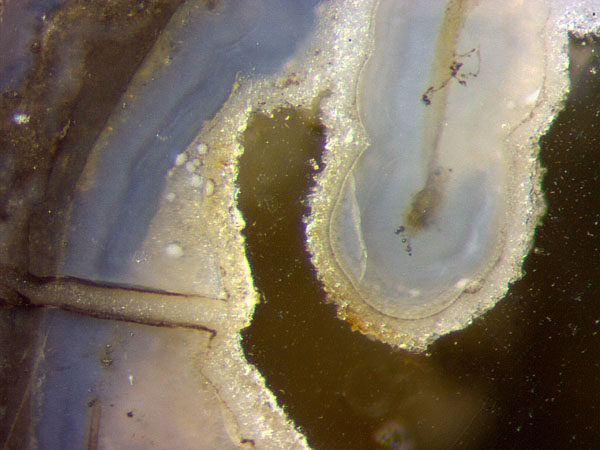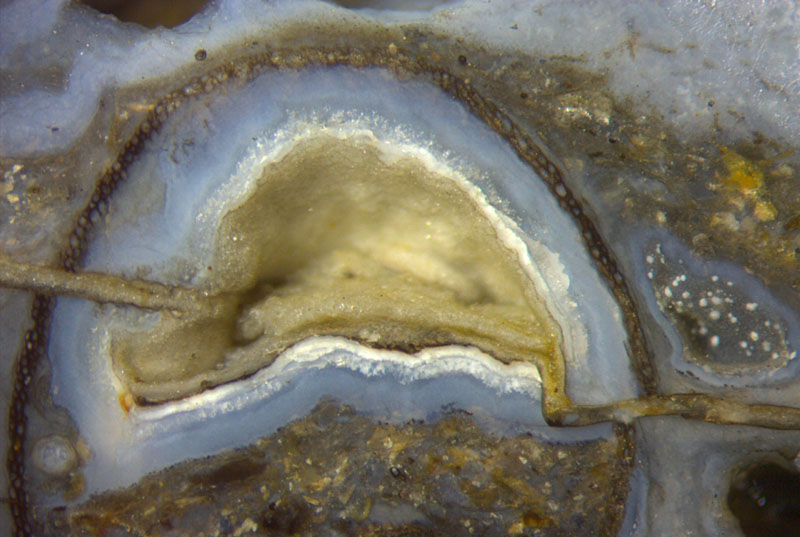Peculiar cracks in Rhynie chert

According
to fracture mechanics, crack
tips in solids are tiny, determined by fracture
toughness and elasticity of the material. Hence the sudden
end of the wide crack in Fig.1 does not seem to make sense at first
sight. A
closer look offers an explanation: The tip of the crack propagating
through the more or less hardened silica gel must have disappeared at
the boundary of the gel against the water in the water-filled cavity
when the crack flanks snapped asunder and became displaced so that
their spacing is
75Ám now.
(The gap width of this "through-crack" is not a characteristic
feature of the material)
Dissolved silica, possibly entering by diffusion
along
the crack, gave rise to a quartz lining on top of the silica gel and in
the crack.
As a conspicuous fact, the gel of the crack flanks has got a distinct
dark stain.
This stain slightly turns around the corners at the end of
the crack. Obviously this stain shows some affinity to the gel surface.
The question arises why not all gel surfaces are stained.
Dark stains or deposits in the Rhynie chert are often due to
microbes. Black filaments and dots of microbial origin are seen enclosed
in gel in Fig.1 on the right.
Also seen in Fig.1 is a fungus hypha grown
in the water-filled cavity before gel deposition, now enclosed in
bluish gel below left, diameter 15Ám.
Fig.1: Detail of a cylindrical cavity left in
silicified
swamp water,
now partially filled with bluish chalzedony, broken, with quartz
cladding. Image width 1.4mm.
Fig.2 (below): Former
cavity of an Aglaophyton
"hollow straw" half filled with mineral debris,
upper half with chalzedony and quartz cladding similar as in Fig.1.
Image width 5.5mm.

The slightly curved thick layer of bluish silica
gel (now chalzedony) on the left of Fig.1 is the lining of a
cylindrical
cavity, 3.3mm across, remaining in the silica gel of
the silicified swamp water (far left, dark) after the complete
decay of an Aglaophyton
shoot.
A similar cavity is seen in Fig.2, here
within a "hollow straw" of Aglaophyton,
half filled with mineral debris so that the bluish
lining is restricted to the upper half of the former
cavity. Again a crack entering from the left ended at the inner surface
of the gel, now chalzedony. Its later formed fill of quartz crystals
merges with the
cladding of the cavity of reduced size. Obviously this
half cavity has got a quartz cladding on the chalzedony similar
to the one in Fig.1.
What looks at first sight
like the seemingly simple phenomenon of "a crack crossing a
fossil" is worth closer consideration. A crack, of
course, cannot propagate through a cavity. It has to find its way
around the cavity. Usually it goes either way round so that there are
two crack fronts which need not meet behind the cavity. Nevertheless,
eventually they connect by a step and move on as one again. The kink of the crack on
the right in Fig.2 might be due to complications of such kind.
The lining in Fig.2 is not all bluish
chalzedony. Part of it, seen here with irregular white reflections, is
coarse crystalline quartz. A small part of this quartz lining is
positioned in the picture plane on the left, where the presence of
coarse grains is obvious from the rugged crack flanks.
The
innermost layer of the lining before crack propagation is chalzedony
partially turned white by Ám-size quartz crystals. This layer had got a
black deposit before the crack had entered into the cavity, as if
microbes living in the water had rained down.
Subsequently the crack was formed, then
crystalline quartz was deposited along the cavity wall and within the
gap. The latest quartz deposit is shaped like a
curved plate, hollow below, which seems
to preclude a simple explanation. Part of the cavity has remained empty.
The white dots inside (Fig.1) and outside (Fig.2)
the hollow plant are
spherulites.
Sample from the collection of Steffen Koehler,
Meissen, collected decades ago by Brian Beveridge,
Gloucester,
on the now protected site near Windyfield formerly owned by A.G. Lyon,
Rhynie; documented here under the label Rh2/303, Parts 1,3.
H.-J. Weiss 2018
 |
 |
131 |





